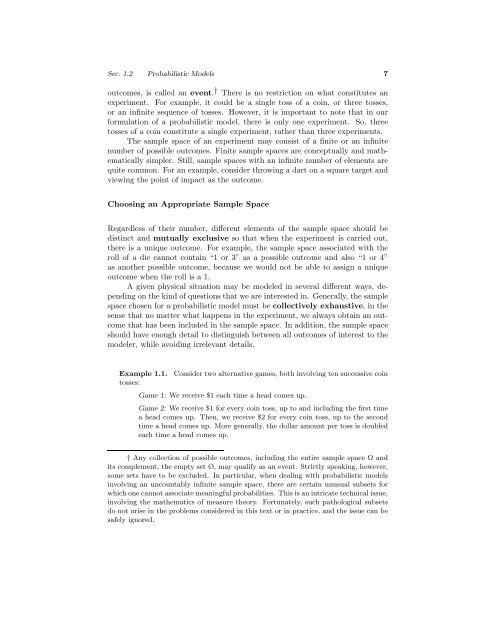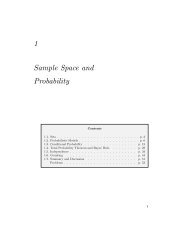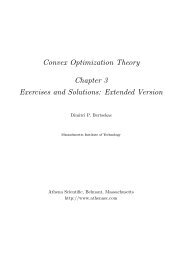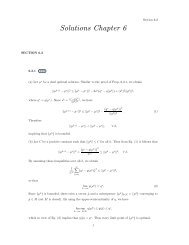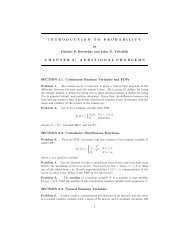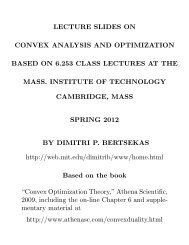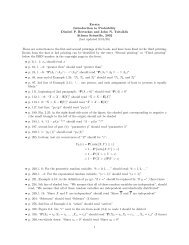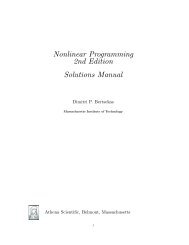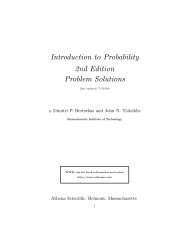Introduction to Probability, by Dimitri P ... - satrajit mukherjee
Introduction to Probability, by Dimitri P ... - satrajit mukherjee
Introduction to Probability, by Dimitri P ... - satrajit mukherjee
Create successful ePaper yourself
Turn your PDF publications into a flip-book with our unique Google optimized e-Paper software.
Sec. 1.2 Probabilistic Models 7<br />
outcomes, is called an event. † There is no restriction on what constitutes an<br />
experiment. For example, it could be a single <strong>to</strong>ss of a coin, or three <strong>to</strong>sses,<br />
or an infinite sequence of <strong>to</strong>sses. However, it is important <strong>to</strong> note that in our<br />
formulation of a probabilistic model, there is only one experiment. So, three<br />
<strong>to</strong>sses of a coin constitute a single experiment, rather than three experiments.<br />
The sample space of an experiment may consist of a finite or an infinite<br />
number of possible outcomes. Finite sample spaces are conceptually and mathematically<br />
simpler. Still, sample spaces with an infinite number of elements are<br />
quite common. For an example, consider throwing a dart on a square target and<br />
viewing the point of impact as the outcome.<br />
Choosing an Appropriate Sample Space<br />
Regardless of their number, different elements of the sample space should be<br />
distinct and mutually exclusive so that when the experiment is carried out,<br />
there is a unique outcome. For example, the sample space associated with the<br />
roll of a die cannot contain “1 or 3” as a possible outcome and also “1 or 4”<br />
as another possible outcome, because we would not be able <strong>to</strong> assign a unique<br />
outcome when the roll is a 1.<br />
A given physical situation may be modeled in several different ways, depending<br />
on the kind of questions that we are interested in. Generally, the sample<br />
space chosen for a probabilistic model must be collectively exhaustive, inthe<br />
sense that no matter what happens in the experiment, we always obtain an outcome<br />
that has been included in the sample space. In addition, the sample space<br />
should have enough detail <strong>to</strong> distinguish between all outcomes of interest <strong>to</strong> the<br />
modeler, while avoiding irrelevant details.<br />
Example 1.1. Consider two alternative games, both involving ten successive coin<br />
<strong>to</strong>sses:<br />
Game 1: We receive $1 each time a head comes up.<br />
Game 2: We receive $1 for every coin <strong>to</strong>ss, up <strong>to</strong> and including the first time<br />
a head comes up. Then, we receive $2 for every coin <strong>to</strong>ss, up <strong>to</strong> the second<br />
time a head comes up. More generally, the dollar amount per <strong>to</strong>ss is doubled<br />
each time a head comes up.<br />
† Any collection of possible outcomes, including the entire sample space Ω and<br />
its complement, the empty set Ø, may qualify as an event. Strictly speaking, however,<br />
some sets have <strong>to</strong> be excluded. In particular, when dealing with probabilistic models<br />
involving an uncountably infinite sample space, there are certain unusual subsets for<br />
which one cannot associate meaningful probabilities. This is an intricate technical issue,<br />
involving the mathematics of measure theory. Fortunately, such pathological subsets<br />
do not arise in the problems considered in this text or in practice, and the issue can be<br />
safely ignored.


